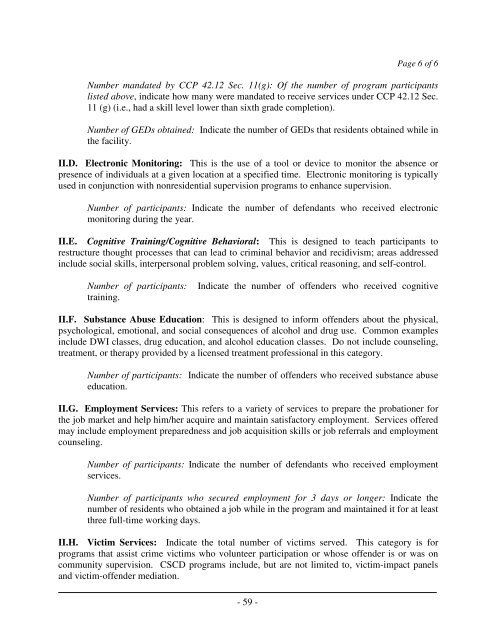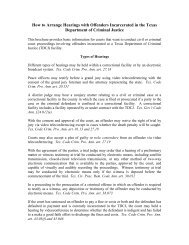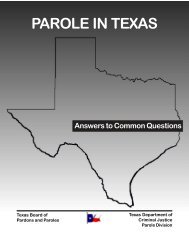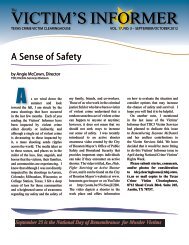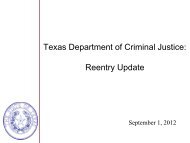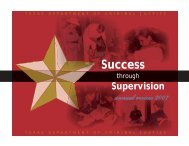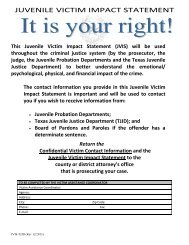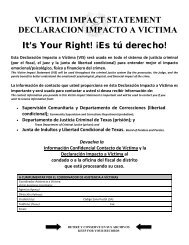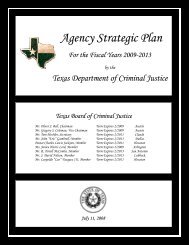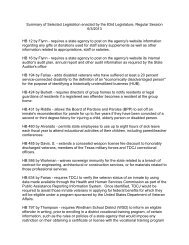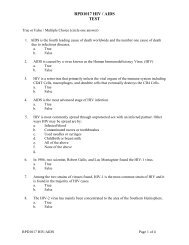TDCJ-CJAD Data Manual - Texas Department of Criminal Justice
TDCJ-CJAD Data Manual - Texas Department of Criminal Justice
TDCJ-CJAD Data Manual - Texas Department of Criminal Justice
You also want an ePaper? Increase the reach of your titles
YUMPU automatically turns print PDFs into web optimized ePapers that Google loves.
Page 6 <strong>of</strong> 6Number mandated by CCP 42.12 Sec. 11(g): Of the number <strong>of</strong> program participantslisted above, indicate how many were mandated to receive services under CCP 42.12 Sec.11 (g) (i.e., had a skill level lower than sixth grade completion).Number <strong>of</strong> GEDs obtained: Indicate the number <strong>of</strong> GEDs that residents obtained while inthe facility.II.D. Electronic Monitoring: This is the use <strong>of</strong> a tool or device to monitor the absence orpresence <strong>of</strong> individuals at a given location at a specified time. Electronic monitoring is typicallyused in conjunction with nonresidential supervision programs to enhance supervision.Number <strong>of</strong> participants: Indicate the number <strong>of</strong> defendants who received electronicmonitoring during the year.II.E. Cognitive Training/Cognitive Behavioral: This is designed to teach participants torestructure thought processes that can lead to criminal behavior and recidivism; areas addressedinclude social skills, interpersonal problem solving, values, critical reasoning, and self-control.Number <strong>of</strong> participants:training.Indicate the number <strong>of</strong> <strong>of</strong>fenders who received cognitiveII.F. Substance Abuse Education: This is designed to inform <strong>of</strong>fenders about the physical,psychological, emotional, and social consequences <strong>of</strong> alcohol and drug use. Common examplesinclude DWI classes, drug education, and alcohol education classes. Do not include counseling,treatment, or therapy provided by a licensed treatment pr<strong>of</strong>essional in this category.Number <strong>of</strong> participants: Indicate the number <strong>of</strong> <strong>of</strong>fenders who received substance abuseeducation.II.G. Employment Services: This refers to a variety <strong>of</strong> services to prepare the probationer forthe job market and help him/her acquire and maintain satisfactory employment. Services <strong>of</strong>feredmay include employment preparedness and job acquisition skills or job referrals and employmentcounseling.Number <strong>of</strong> participants: Indicate the number <strong>of</strong> defendants who received employmentservices.Number <strong>of</strong> participants who secured employment for 3 days or longer: Indicate thenumber <strong>of</strong> residents who obtained a job while in the program and maintained it for at leastthree full-time working days.II.H. Victim Services: Indicate the total number <strong>of</strong> victims served. This category is forprograms that assist crime victims who volunteer participation or whose <strong>of</strong>fender is or was oncommunity supervision. CSCD programs include, but are not limited to, victim-impact panelsand victim-<strong>of</strong>fender mediation.- 59


